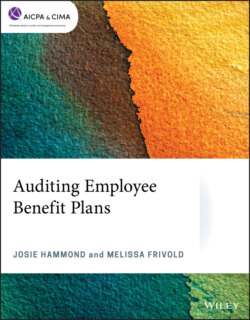Читать книгу Auditing Employee Benefit Plans - Josie Hammond - Страница 22
Defined benefit plans Traditional defined benefit plans
ОглавлениеThe press would have you believe that the traditional defined benefit plan is dead. However, many such plans remain and they are among the most complex for the plan auditor to address. Part of the complexity is associated with the nature of the arrangement. Auditing a defined contribution plan is a lot like auditing a bunch of investment accounts. When auditing a defined benefit plan, the auditor has to deal with actuarial concepts and benefits that have accrued over decades. Further, most of the defined benefit plans surviving today are the result of numerous mergers. Thus, a single benefit plan may have multiple layers of benefit accruals under different plan formulas. Finally, because plan assets must be managed to fund these predetermined benefit levels, the investment portfolios frequently include complex financial instruments.
Traditional defined benefit plans build up a promise of a future lifetime benefit to a participant and his or her beneficiary based upon the plan’s benefit accrual formula. Three basic features—the benefit formula, the accrual method, and vesting—affect that future benefit. Vesting is a concept that is common to all plans and will be discussed later, but the other two concepts are unique to defined benefit plans:
Benefit formulas. Defined benefit plans may calculate future benefits based upona simple percentage of pay, say 40 percent;an annual approach, say 1 percent of pay for each year of service;a flat approach, say $1,000 per month at normal retirement age; orthey may combine the last two methods, say $100 per month per year of service. The definition of “pay” for this purpose may be based upon each year’s eligible pay, an average of pay over a career or an average of pay over some period of time. For example, a common defined benefit plan formula would be 40 percent of final average pay based upon the last five years of employment. These formulas may also be combined with Social Security.
Accrual of benefits. In addition to the formula defining benefits, a defined benefit plan will provide a system for employees to accrue these future benefits. Benefits may accrue over an employee’s working career, a fixed number of years or some other method that is defined in the plan document.
Help desk. The way these rules function together is easiest to understand for a simple percentage of pay plan. Assume the plan promises 30 percent of pay at normal retirement age and accrues benefits ratably over 25 years. If John Smith works for 10 years before quitting, he will be fully vested in his benefit, but rather than receiving 30 percent of pay at normal retirement age, his accrued benefit is only 12 percent of pay. That is 10 years of service, divided by 25 required years of service or 40 percent accrued times the 30 percent of pay benefit equals 12 percent of pay.
10 years/25 years required = 10/25 = .4 × 30% = 12%
The calculation of benefits is not the only complexity of defined benefit plans. Funding is based upon actuarial calculations. Fully insured plans—”412(i) plans”—do not require an actuary.
Distributions are required to be made as an annuity, unless the participant elects another form. Spousal consent is required for all preretirement distributions.
These arrangements are generally subject to the jurisdiction of the Pension Benefit Guaranty Corporation (PBGC), which insures a base level of the plan’s benefits. The termination and certain amendments of the plan typically require a notice to and, possibly, the approval of the PBGC before they can be effective. Employees are to be notified in advance of plan amendments, which will reduce future benefit accruals.
As if this was not complicated enough, the Pension Protection Act of 2006 created a concept governing the operation of the defined benefit plan. This is the adjusted funding target attainment percentage, or AFTAP. To the extent that the AFTAP falls below specified levels, limitations or restrictions are imposed upon
benefit increases,
benefit accruals,
distributions in a form other than an annuity, and
shutdown benefits.
The plan’s actuary will certify to the plan’s AFTAP.
